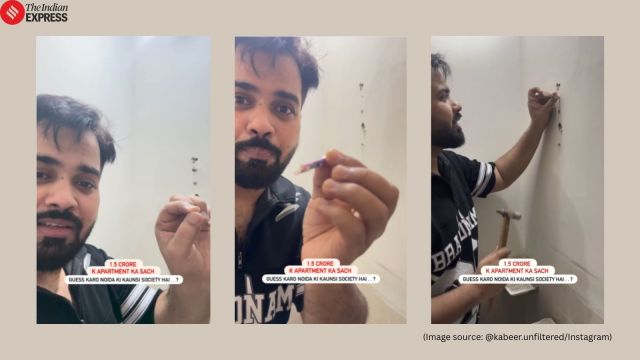Noida man makes hole in Rs 1.5-crore flat’s wall with pencil, leaves internet stunned: ‘Gaon ke ghar zyada mazboot hain’
The video quickly went viral, sparking heated discussions about the quality of construction in pricey housing projects.
 Instead of a drill, he taps a pencil with a hammer, effortlessly creating a neat hole.
Instead of a drill, he taps a pencil with a hammer, effortlessly creating a neat hole.Many people invest their life savings in luxury apartments in metropolitan cities, believing they’re buying safety and high-quality construction. But a recent video from a high-rise in Noida, reportedly priced at around Rs 1.5 crore, has left the internet shocked.
In the clip, a resident reveals just how fragile the walls of his flat are. Instead of using a power drill, he presses a wooden pencil against the wall, gives it a light tap with a hammer, and within seconds, a hole appears.
In his video, the resident said, “This hole in the wall was made using a pencil. I placed the pencil against the wall, hit it with a hammer, and it went right in. When I first tried using a drill, and then used the pencil, the pencil went straight through the wall. It’s a wooden pencil with graphite, which we used in school. That’s how the house has been built, so weak that you don’t even need a drill. You can make a hole in the wall just with a pencil.”
He shared the clip with a frustrated caption: “Apna ghar dusron se banwao to unke sar par khade reh banwao bhai… warna ye milega! Ye kaisa ghar bana diya??” (When you get your house constructed by others, stand right over their heads and supervise… or else this is what you’ll get! What kind of house is this?)
Check out the post:
View this post on Instagram
The video quickly went viral, sparking heated discussions about the quality of construction in pricey housing projects. However, some viewers were quick to clarify that these are non-structural Autoclaved Aerated Concrete (AAC) walls – lightweight materials often used in high-rise buildings for safety and efficiency.
One user tried to educate others, writing, “Those are non-structural AAC walls. They aren’t weak – they’re lightweight, eco-friendly, fire-resistant, and provide good insulation. Since they’re non-load-bearing, they actually make a building safer during earthquakes. We’re just used to the purane zamane ke eent pathar ke ghar (the old brick-and-stone houses), so this feels shocking – but in breaking it, you’re only damaging your own home.”
Another comment read, “Brother, these are AAC blocks – autoclaved aerated concrete. They have air pockets that make them light, which is why drilling is so easy. This is why knowledge is important.”
But not everyone was convinced. “How bad it feels to have been cheated, investing almost a crore in such poor infrastructure,” one user wrote.
“Even gaon ki mitti ke ghar (the mud houses in villages) are stronger than this,” said another.
- 01
- 02
- 03
- 04
- 05































